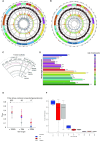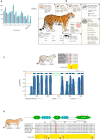Near-chromosomal de novo assembly of Bengal tiger genome reveals genetic hallmarks of apex predation
- PMID: 36576130
- PMCID: PMC9795480
- DOI: 10.1093/gigascience/giac112
Near-chromosomal de novo assembly of Bengal tiger genome reveals genetic hallmarks of apex predation
Abstract
The tiger, a poster child for conservation, remains an endangered apex predator. Continued survival and recovery will require a comprehensive understanding of genetic diversity and the use of such information for population management. A high-quality tiger genome assembly will be an important tool for conservation genetics, especially for the Indian tiger, the most abundant subspecies in the wild. Here, we present high-quality near-chromosomal genome assemblies of a female and a male wild Indian tiger (Panthera tigris tigris). Our assemblies had a scaffold N50 of >140 Mb, with 19 scaffolds corresponding to the 19 numbered chromosomes, containing 95% of the genome. Our assemblies also enabled detection of longer stretches of runs of homozygosity compared to previous assemblies, which will help improve estimates of genomic inbreeding. Comprehensive genome annotation identified 26,068 protein-coding genes, including several gene families involved in key morphological features such as the teeth, claws, vision, olfaction, taste, and body stripes. We also identified 301 microRNAs, 365 small nucleolar RNAs, 632 transfer RNAs, and other noncoding RNA elements, several of which are predicted to regulate key biological pathways that likely contribute to the tiger's apex predatory traits. We identify signatures of positive selection in the tiger genome that are consistent with the Panthera lineage. Our high-quality genome will enable use of noninvasive samples for comprehensive assessment of genetic diversity, thus supporting effective conservation and management of wild tiger populations.
Keywords: Bengal tiger; ROH; genome assembly; reference genome.
© The Author(s) 2022. Published by Oxford University Press GigaScience.
Conflict of interest statement
MedGenome Inc. employee K.S. held options in the company.
Figures



References
-
- WWF. Tiger page. https://www.worldwildlife.org/species/tiger. Accessed 10 Jan 22.
-
- Luo SJ, Liu YC, Xu X. Tigers of the world: genomics and conservation. Annu Rev Anim Biosci. 2019;7(1):521–48. - PubMed
-
- Ripple WJ, Estes JA, Beschta RL, et al. Status and ecological effects of the world's largest carnivores. Science. 2014;343(6167):1241484. - PubMed
-
- Task Force IBfWL . Project Tiger: A Proposal for Preservation of the Tiger (Panthera tigris tigris Linn.) in India. New Delhi, India: Ministry of Agriculture, Government of India, 1972.
Publication types
MeSH terms
Grants and funding
LinkOut - more resources
Full Text Sources
Miscellaneous

